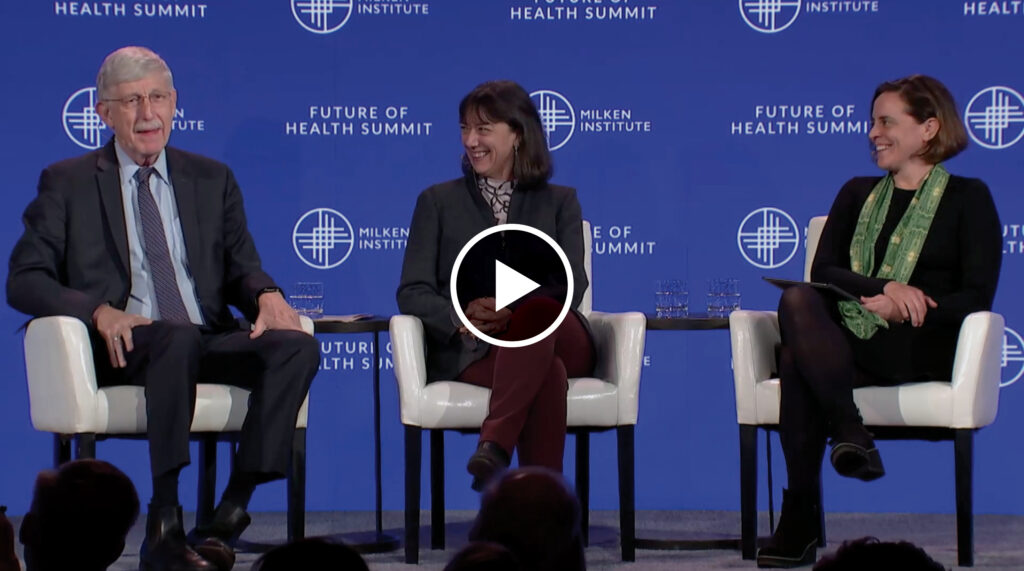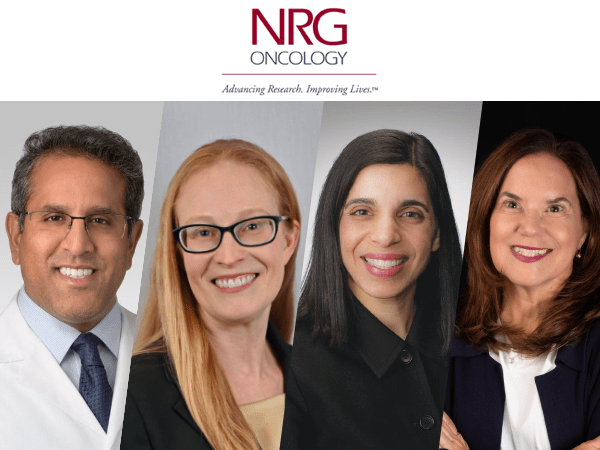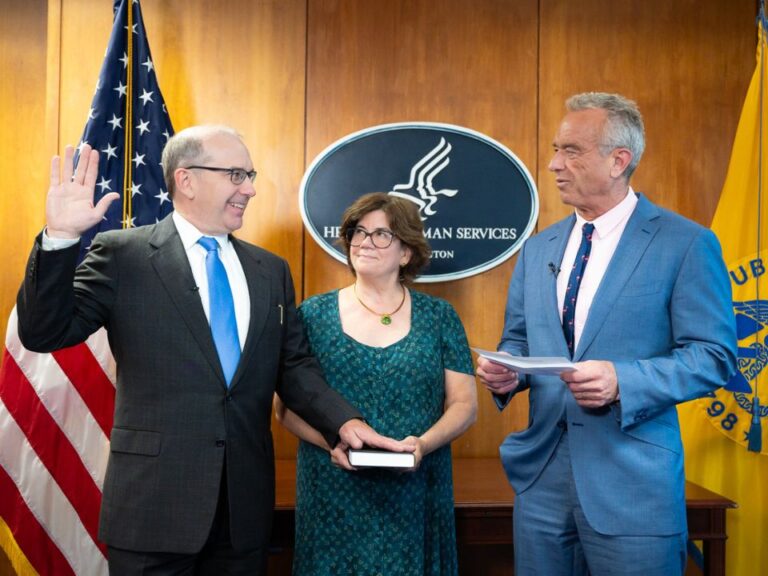Within two months of stepping in as director of the Advanced Research Projects Agency for Health, Renee Wegrzyn has grown her staff fivefold, built a website, juggled 30 congressional meetings, and met with 10 patient advocacy organizations.
As the inaugural leader of the newest federal agency—supercharging cancer research is part of its raison d’etre—Wegrzyn said she is working closely with NCI Director Monica Bertagnolli to ensure that their respective institutions would not only complement each other, but also synergize.
“I never thought I was going to build a government agency. It’s great to be wanted. I was never the prom queen,” Wegrzyn said Nov. 6 at the Milken Institute Future of Health Summit, speaking with Bertagnolli at a fireside chat moderated by former NIH Director Francis Collins. “There’s a long tradition of ARPAs working with NIH, first of all, I think it’s important to remind folks of.
“But from where I sit today, having a lot of pressure to spend $1 billion and hire program managers, more than 90% of my time is spent trying to hire those folks.”
A video of the session is available here.
Today, all eyes are on Wegrzyn, who was named ARPA-H director Sept. 12, to deliver on the promise of a high-risk, high-reward R&D model based on the Defense Advanced Research Projects Agency.
Congress authorized $1 billion for ARPA-H in FY22, and Department of Health and Human Services Secretary Xavier Becerra established the agency within NIH. However, Wegrzyn reports directly to the secretary and has the authority to set an independent agenda (The Cancer Letter, June 24, 2022).
Wegrzyn was an executive at a genetic engineering biotech and a former program manager of biological technologies at DARPA. She received her PhD in molecular biology and bioengineering from the Georgia Institute of Technology in 2003 (The Cancer Letter, Sept. 16, 2022).
Bertagnolli and Wegrzyn were in touch before they stepped into their new roles. Oct. 3 was Bertagnolli first day on the job at NCI (The Cancer Letter, Oct. 7, 2022).
“Even before both of us started, Renee and I were together plotting about how we really can capitalize on the differences between our respective agencies, and the strengths of both, and make sure that the whole is going to be much greater than the sum of the parts, because of the very complementary approach,” Bertagnolli said at the health summit in Washington.
The location and size of ARPA-H’s headquarters has not been determined, but Wegrzyn expects the brick-and-mortar presence of the agency to be rather spartan.
“It would be a really boring office building, probably a floor—maximum. It’s really such a small footprint,” Wegrzyn said. “So, I think, just to myth-bust a little bit, it’s not going to be a sprawling NIH campus. There’s no intramural research, it’s exclusively extramural. And when I was a program manager at DARPA, I spent 40%, 50% of my time on the road.”
Program managers are not expected to move to ARPA-H’s headquarters, since travel is a job requirement, and because they would stay on the job for only about three years, per the agency’s term appointment limits. The directorship is also subject to a term limit of about five years.
ARPA-H has four initial focus areas, Wegrzyn said:
- Health Science Futures—expanding what’s technically possible,
- Scalable Solutions—reaching everyone quickly,
- Proactive Health—keeping people from being patients, and
- Resilient Systems—building integrated healthcare systems.
“My job as an inaugural director is to really create that environment where program managers can come, take risks—it’s okay to fail—but to be very well-resourced, and then have support from the NIH, from HHS, and the rest of the health ecosystem, to be able to take those big bets,” Wegrzyn said. “Please remember to give us that space to fail a little bit.
“We do have prize authority, so I’d be pretty excited if we launch a couple of prize challenges.”
Collins, who was involved in the White House’s recruitment of both Wegrzyn and Bertagnolli, focused much of the hour-long conversation on how the two directors would collaborate on the latest developments in biomedical research.
Collins served as interim co-chair of the President’s Council of Advisors on Science and Technology and as science advisor to President Joe Biden after Eric Lander stepped down from the cabinet role in February (The Cancer Letter, Feb. 18, 2022).
“A lot of people—knowing that there’s a new NCI director and there’s a brand-new ARPA-H, with its new director—are wondering how are these entities going to work together when it comes to something like cancer research, which is at a moment of enormous potential and excitement, as both of you would agree,” Collins said at the summit. “It’s not going to arrive as a surprise that people will say, ‘Well, that ought to be an ARPA-H project. Well, that ought to be an NCI project.’ How are you all going to deal with this?”
The Collins Quiz included questions on cancer vaccines, mRNA, artificial intelligence and machine learning, multi-cancer detection, and on what success looks like in five years.
Following are excerpts of Bertagnolli and Wegrzyn’s responses:
On cancer vaccines and mRNA
Wegrzyn: On the mRNA side, let’s say it’s improving how it might be packaged and delivered… whatever it might be. There’s still so much fundamental development that needs to happen.
But then, to get to those applications, improve the concepts where you could fund a portfolio of teams—maybe one is addressing cancer and one is addressing Alzheimer’s disease and one is addressing diabetes, or you name it—but I think what that does is it really challenges the platform.
It might not work in every scenario, but it starts to show the utility of advancing that technology.
What it also does is it pushes our regulators to think about how are they going to address this when they see a platform technology coming their way. We’ve had those real-world experiences from DARPA times. And we’ve been engaging FDA already.
And then, I would hope to engage Monica and the NCI team … “Is this really pushing the boundaries? This looks interesting to me, but you’re the subject-matter expert.”
So, that would be one way to engage. And then, once we’re going through the reviews of these types of projects, we would invite our colleagues not only in NIH, but other stakeholders out there to help us review and provide perspective on the proposals, but the program manager is the decision maker.
That’s how you can take those really high risks. It’s not decided by committee.
And then, once the program is kicked off, it’s really working side-by-side, understanding what are the assays that we need to be doing? Is this going to be accepted by your communities?
Bertagnolli: We have a really, really rich group of individuals, scientists and forward-thinkers who are very interested in mRNA vaccines for cancer already.
We might loan you a project manager if you promise to give them back.
This is a perfect collaboration, because we would view our expertise as sitting at the elbow of the developers of some of these new platforms and techniques to make sure that what’s being developed can then serve the needs of the cancer research community.
And then, when the time is appropriate, initial testing and maybe even several rounds, back and forth, we’re standing ready to take it further.
And so, the approaches are incredibly complementary.
On AI/ML
Wegrzyn: This is definitely something that Monica and I have been talking about for a while.
And she really described to me… how siloed some of this data is.
If there’s already investment by NCI, what are the gaps that are not yet addressed that an injection of capital to try to pursue new solutions on goal? That would be the place for ARPA-H to play a role.
Renee Wegrzyn
And that research data and understanding of 3D histopathology imaging is just not shared widely—where you might gain an insight in Seattle, but that would never benefit a patient across the country.
And so, we know there’s been a lot of advances in AI/machine learning for image interpretation, radiology being the simplest form.
But when you think of 3D tissues, you can think about innovative new histopathology assays that ARPA-H can fund. We can look at multichannel, multicolor imaging and analysis and diagnostics that can be done in an automated way.
And then, working with colleagues at NCI or maybe NIDDK for something like diabetes, we can think about, how do you then use this to bring to doctors and patients and improve standard of care.
So, that would be, I think, a really concrete one if there’s a program manager out there that wants to pursue it. But those would be the types of things that we would want to attack, I think, on our side.
Bertagnolli: I think the researcher at your elbow could come from a great number of different areas of focus. Someone who’s really keyed in on systems biology, who really wants to understand the intricate relationships between the many different cells that create a tumor microenvironment and their relationship to the tumor.
For instance, this goes way beyond our conventional diagnostics right now, which is to basically take a 2D slice through something and try to look at the proteins that are expressed there. We’re really talking about a complete three-dimensional look, and that could even be set in a time series.
Just the techniques for the data analysis alone could be a project for ARPA-H. And so, this would be one that I think would be fantastic.
It would be a fantastic collaboration from the get go to put our two different teams together to work on something like this.
On multi-cancer detection assays
Bertagnolli: NCI is launching a very large program to test the multi-cancer detection assays clinically, to really put them out there in clinical trials first, beginning with an exploratory trial that will set this, that will gather information about different assays, how they perform, how they perform in diverse populations. That’s going to be 24,000 patients launched in the first trial.
And then, an estimated 225,000 patients who will be required to test a more definitive study that really looks at all the populations we need and the implications for our healthcare system, and the effect on what we care about most, which is death due to cancer, and health overall.
So, we are committing to that large-scale clinical testing. And in fact, we’re beginning it within the next year.
Wegrzyn: I think after hearing Monica describe the incredible investment from NCI, I would really question, what is the specific role for these types of assays for ARPA-H?
But you defined a problem in your question, which was how do you detect cancers very early, so that we can treat them before they become a bigger problem.
I would say, that would be our starting place. And so, if there’s already investment by NCI, what are the gaps that are not yet addressed that an injection of capital to try to pursue new solutions on goal?
That would be the place for ARPA-H to play a role.
What success looks like—in five years
Wegrzyn: Looking back, it would really be, have we established the culture that we allow these audacious big bets to go forward and that somebody can point at the programs, without knowing who funded it? No, it was ARPA-H, because of how big it was.
I think if we’re successful, we’ve actually also failed as well, because we need to have the room to take big bets. And sometimes, those risks are so big that they won’t be successful. And so, when I speak to Congress, that’s what I usually remind them.
Bertagnolli: NCI takes the long view. And we were just tasked by the Biden administration with a new reinvigorated moonshot—one goal within 25 years to reduce the death rate from cancer by 50%.
If we really work hard, if we eliminate disparities in our society, we’re going to get there. We’re going to get to that 50% reduction, hopefully well beyond it. But there was another challenge set for us, and that was to “end cancer as we know it,” and we’ve been working really hard to define what does that mean.
We need to learn from absolutely everybody. Data sharing. We talk about data sharing all the time. It’s not done to the extent that it needs to be. Why?
Because it’s hard. We’re going to be looking to Dr. Wegrzyn and her team perhaps for giving us some new good tools for data sharing.
We have to prevent more tumors, understanding the biology that it takes to be able to understand risk and know how to target prevention, but also get everyone out there to do what needs to be done.












